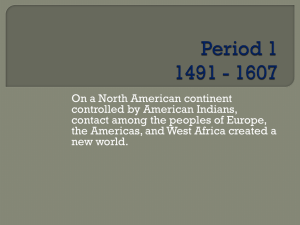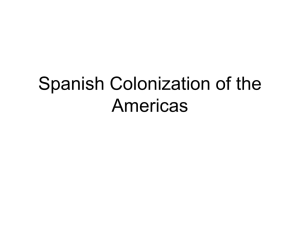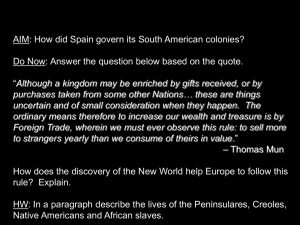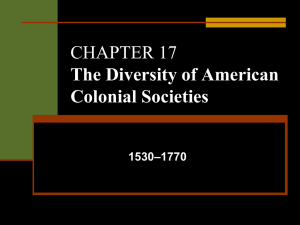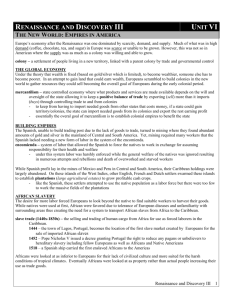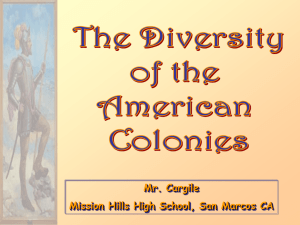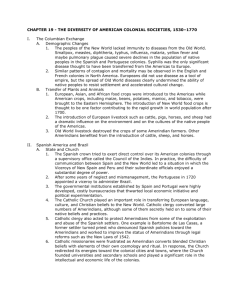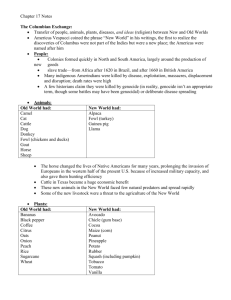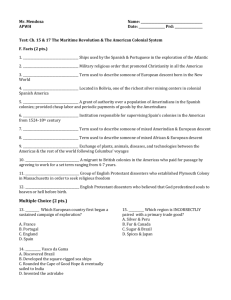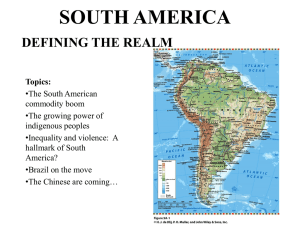Chapter 17 The Diversity of American Colonial Societies
advertisement
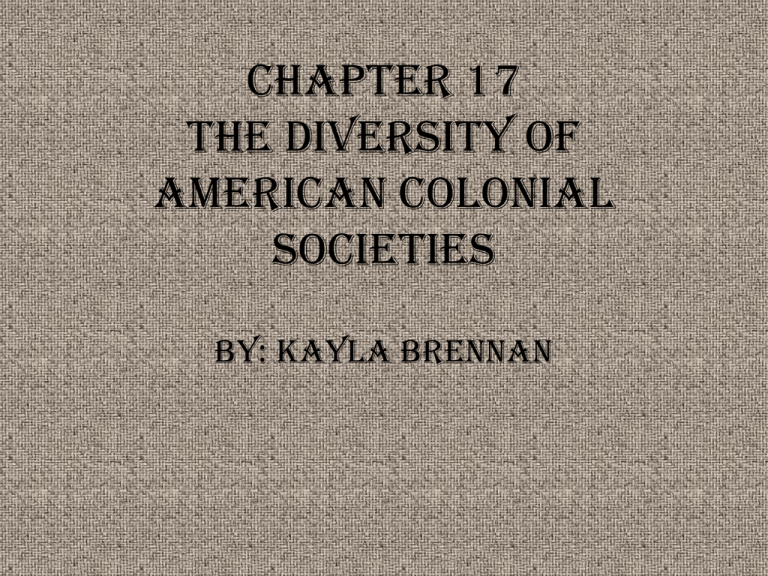
Chapter 17 The Diversity of American Colonial Societies By: Kayla Brennan Colombian Exchange • It was the transfer of people, animals, plants, agriculture, and diseases between the Old and New Worlds. • Diseases from the Old World wiped out the majority of the native population. • Spain and Portugal, England, and France became areas of cultural and social experimentation. Demographic Changes • Death rates in the New World were very high due to lack of immunity. • New World staple crops impacted European, Asian, and African diet and agriculture. • Livestock were brought to the New World and therefore altered the land and jobs of the natives. Spanish Colony • Spain and Portugal expanded into the New World rapidly. • The Spanish and Portuguese set up there societies based on cultures and traditions of their own lands. • Amerindian culture and practices continued. • African slave trade began. State Spanish • Council of the Indies supervised the Spanish Colony. • There were many areas controlled by viceroys. • Taxes were in gold and silver. Portuguese • They set up administrative responsibilities. • They eventually had a viceroy in Brazil. • Sugar plantations and gold mines= intrusive colonial bureaucracy. Church Spanish And Portuguese • Wanted to convert Amerindians to Christianity • Began using torture, executions, and destruction of native manuscripts • Bartolome de Las Casas protested the natives’ treatment • Amerindian Christianity came out which was the blend of their beliefs with Catholic rituals associated with the Virgin Mary • Churches made improvements to intellectual life – The printing press – Universities – Secondary schools Economy Spanish Portuguese • Silver mines dominated the economy • Encomienda- forced labor on the Amerindians • Low Amerindian populations led to free wage labor • Became a Spanish speaking Catholic colonial society • Increased trade • Sugar plantations dominated the economy in Brazil • Worked by Amerindian slaves at first, but changed to African slaves • This connected them commercial links around the world Society Spanish and Portuguese • Populations dominated by Africans, Amerindians, and creoles • Creoles were whites born in the Americas • Indigenous elite became closer to Spanish authorities to help them survive • Afro-Iberian slaves had similar roots of Spain and Portugal • African slaves had different languages, beliefs, and practices • Black populations grew and a lot of them bought their freedom English Colony • Multiple failed attempts to settle in the New World • Jamestown brought 144 settlers to VA but 80% died • The survivors stayed and moved inland • They discovered tobacco and this brought more settlers. • Immigrants that could not afford the trip were brought as indentured servants. Government • They were ruled under the House of Burgesses and a governor and his council • They had major fur trade • Altered the environment and Amerindian agriculture The Carolinas • They used slavery and plantations • African slaves brought new agricultural techniques • South Carolina had a hierarchy type society – The rich at the top – Small farmers, cattlemen, artisans, merchants, and fur traders were middle class – Indigenous people and slaves were at the bottom New England • Pilgrims wanted to break off of the England church so they emigrated to the Americas. • Settled in Plymouth and dispersed according to their beliefs. • Puritans wanted to purify the Church of England. • They set up Massachusetts Bay Colony and absorbed Plymouth. • Little diversity, no agriculture, few slaves • Shipped and provided commercial services The Middle Atlantic Region • English speaking societies • Dutch settle on Manhattan Islands and Quakers settle Pennsylvania • New York: large commercial and shipping center • Pennsylvania: grain-exporting colony • Traded with Iroquois Confederacy French Colony • Interested in beaver and other animals’ furs • Made allies with Huron and Algonquin Indians • Couveurs de bois- were sent to live among native tribes and master their customs • Deadly wars between Algonquin and Iroquois • Firearms spread and mixed in some areas with horses French • Jesuits converted natives to Christianity • Native religions persisted so they used money to build schools, hospitals, and churches. • Eventually they lost Canada to the English and lost Louisiana to Spanish. Summary • All of the colonies applied their knowledge from the Old World to the transforming of the New World. • They all permanently altered the native peoples. • They brought African Americans to the New World creating diverse societies. • They also brought silver, sugar plantations, and fur trade into the commercial networks of that time period.



